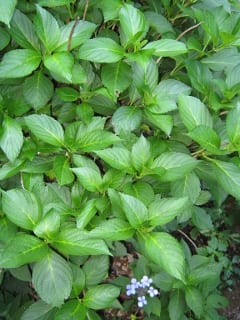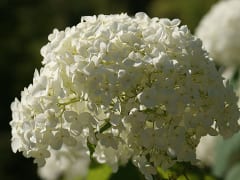A combination of bitterly cold temperatures and high winds last winter has resulted in disappointing hydrangea blooms in parts of New England this summer. Are there sustainable options to safeguard blooms in the midst of extreme weather conditions?
I have dealt with this problem for 20 years and have had luck wrapping my hydrangeas in burlap. My particular method has been using four wooden tomato stakes hammered into the ground around the bush and attaching burlap to the stakes to create a room for the bush. After the ground has frozen, I fill this “room” with some leaves. I suggest double wrapping with burlap on known windy sites. This helps cut down the cold winds that dry out the flower buds. I attach the burlap to the stakes using big black paper clips capable of opening one inch or more. It’s quick and easy.
Bruce Wenning, Horticulturist, The Country Club, Brookline, MA.
Unfortunately, this past winter was hard on a lot of plants that we normally consider “bulletproof.” Generally, hydrangeas can have a disappointing bloom set for a number of reasons (drought the previous season, poor pruning, etc.) Two ways to alleviate this: 1. Plant our native Hydrangea arborescens. It blooms on new growth, so it never loses flower buds over the winter; or 2. If you have to have that giant blue mophead of Hydrangea macrophylla, think about siting it somewhere that it won’t be exposed to damaging winter winds and extreme temperature fluctuations. Plant it in a protected area where it won’t be exposed to northern winds and late afternoon (western) sun.
Mark Richardson, Director of Horticulture, New England Wild Flower Society, Framingham, MA
All of us who have hydrangeas had disappointing bloom this past summer! Here are some thoughts: Add some varieties that bloom on new wood to your hydrangea grouping. Generally Hydrangea arborescens (Smooth Hydrangea, a white-flowered native), and Hydrangea paniculata (a larger shrub that can be pruned to tree-form) bloom on new wood, so the flower buds cannot be killed during a cold winter because they have not formed yet. Also, the new “Endless Summer ” varieties bloom both on old and new wood, if you are looking to keep the blue mophead look. You can wrap your hydrangeas with burlap or another protective fabric, or bank them up with fallen leaves, late in the fall to protect them. Look around your garden for warmer “microclimates” protected from wind and harsh direct winter sunlight when placing new hydrangeas. Mophead hydrangeas also do very well in large garden pots and can be brought inside to a cool garage for the winter as long as they receive some water and light. Other reasons hydrangeas may not bloom include mistimed pruning (check whether yours bloom on old or new wood; the pruning times are different) and deer or rabbit browse.
Amanda Sloan, Landscape Architect, GLA/BETA Group, Inc., Norwood, MA
To avoid loss of blooms, choose Hydrangeas that bloom on new wood such as Hydrangea peniculata ‘Grandflora’, commonly called peegee (native of China and Japan) which is extremely winter hardy (Zone 4). This hydrangea can be grown as a single trunk specimen or a multi-stemmed shrub. In addition to the species there are many compact cultivars available (which typically grow to only about 6-7′), which include ‘Limelight’, ‘Pinky Winky’, ‘PeeWee.’ Even shorter ones such as ‘Little Lime’ and ‘Baby Lace’ to name a few max out at about 4-5′ depending on the cultivar. They all have large pyramidal flower with sterile and fertile florets which appear in late summer and remain on the plant for months.
Another hardy variety is H. arborescens (Zone 3), native from New York to Florida and west to Iowa, Missouri, Oklahoma, and Louisiana. It typically grows 3-5′ tall. Tiny white fertile flowers bloom in May-July in flattened hairy clusters (corymbs to 2-6”across). The cultivar ‘Annabelle’ is probably the best known, blooming in June-July with clusters of sterile, white flowers that appear in huge, symmetrical, rounded heads. But unless this is pruned and thinned it tends to flop. There are some new sturdier cultivars such as ‘Incrediball’ which is reported to have larger flowers (up to 12” in diameter) and very sturdy stems, so no flopping. ‘Invincibelle Spirit’ and ‘Bella Anna’ are pink arborescence, and these too are reported to be non-floppers. Or check out ‘Hayes Starburst’ for its star-shaped double white flowers arranged in showy mophead clusters.
For all Hydrangea it’s best to provide sufficient moisture particularly during droughty times as they will flag if “thirsty.” And although these hydrangea are hardy, they benefit from a good deep watering in the fall and mulch applied to the root zones for added winter protection. Always mulch after the ground freezes to make sure that unwanted visitors don’t find a cozy home and some delicious stems to nibble on in the winter.
Kathy Sargent-O’Neill, KSO Fine Garden Design and Care, Bourne, MA



